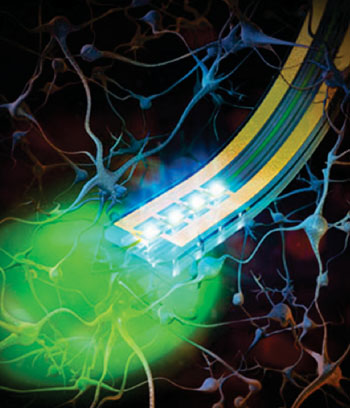Wireless Device Modulates Drug Delivery to Brain
By HospiMedica International staff writers
Posted on 05 Aug 2015
A novel wireless device as narrow as a human hair can be implanted in the brain and activated by remote control to deliver therapy.Posted on 05 Aug 2015
Developed by researchers at Washington University (WUSTL; St. Louis, MO, USA) and the and the University of Illinois (Urbana-Champaign, USA), the implantable device is based on optogenetics, a technology that first makes individual brain cells sensitive to light, and then activates those targeted populations of cells with flashes of light. The implant is thus capable of delivering light or drugs to specific areas of the brain to treat pain, depression, epilepsy, and other neurological disorders, improving targeted drug delivery and reducing side effects.

Image: The remote controlled optogenetic implantable device (Photo courtesy of Alex David Jerez Roman / WUSTL).
As part of the study, which was conducted in mice, the researchers delivered a drug to just one side of an animal’s brain, stimulating neurons involved in movement, which caused the mouse to move in a circle. In other mice, shining a light directly onto brain cells expressing a light-sensitive protein that prompted the release of dopamine, a neurotransmitter that rewarded the mice by making them feel good; the mice then returned to the same location in a maze to seek another reward. They were also able to interfere with the light-activated pursuit by remotely blocking the action of dopamine on its receptors.
The implant currently contain four chambers that carry drugs directly into the brain via microfluidic channels and microscale pumps, but it is soft (like brain tissue), and can remain in situ and function for a long time without causing inflammation or neural damage. In future, the researchers hope to include a cartridge design—much like a printer’s ink cartridge—so that drugs can continue to be delivered to specific cells in the brain or elsewhere in the body for as long as required, without the need to replace the entire device. The study was published online on July 16, 2015, in the journal Cell.
“In the future, it should be possible to manufacture therapeutic drugs that could be activated with light,” said co-principal investigator Michael Bruchas, PhD, an associate professor of anesthesiology and neurobiology at WUSTL. “With one of these tiny devices implanted, we could theoretically deliver a drug to a specific brain region and activate that drug with light as needed. This approach potentially could deliver therapies that are much more targeted but have fewer side effects.”
“Now, we literally can deliver drug therapy with the press of a button. We’ve designed it to exploit infrared technology, similar to that used in a TV remote,” added study coauthor Jordan McCall, PhD. “If we want to influence an animal’s behavior with light or with a particular drug, we can simply point the remote at the animal and press a button.”
Related Links:
Washington University
University of Illinois














